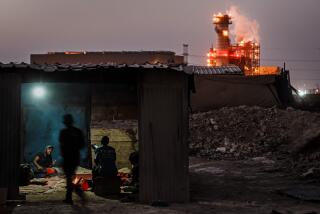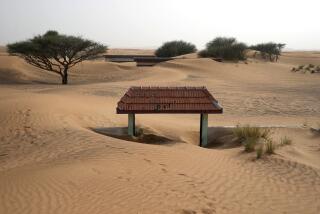Crisis in Gulf Threatens Rug Weavers : Jordan: Tourists, normally the primary buyers, have been scared away. Meanwhile, an American woman is helping Bedouins revive the disappearing art.
- Share via
MAKAWIR, Jordan — With the drums of war beating in the Persian Gulf, the ancient Bedouin art of rug weaving is looking a little threadbare.
Tourists, who normally buy most of the rugs made by Jordan’s Bedouins, have been scared away by the threat of war since Iraq invaded Kuwait in August.
Many Jordanians are wary of buying luxuries while their country struggles to overcome the adverse effects of U.N. sanctions against Iraq. Jordan’s economy has been hard hit by the sanctions, which have deprived it of lucrative trade with Iraq.
“Everyone here has heard of the trouble in the gulf,” said Um Khalaf, among at least 3,000 Bani Hamida tribespeople who left their nomadic lifestyle in the 1970s and settled in and around this mountain village 45 miles south of Amman.
“May God knock sense into the Arabs. Life is expensive as it is and this trouble is making it harder for us,” said the blue-eyed Bedouin woman as she stirred raw wool in a caldron bubbling with red dye.
Rebecca Salti, an American who helped revive the Bedouin art of weaving and dyeing to produce some of Jordan’s best rugs, says Um Khalaf and her colleagues have cause to worry about their livelihood.
Salti, director of Jordan’s Save the Children Fund, started the Bani Hamida weaving project five years ago to help women use their age-old skills to earn money.
“These women did not have cash at their fingertips to educate their kids or visit the doctor,” said Salti, who is married to a Jordanian banker.
She said the project has dropped plans to market Bani Hamida rugs in the gulf and is having trouble with Western importers.
“Since the trouble began, they have had no confidence that Jordan can produce orders on time,” Salti said. “We can if we are given the choice.”
Dyes are another problem.
“All our dyes are imported from the United States and, with war insurance and a surcharge on freight, prices will double, making our products less competitive,” Salti said.
Competition comes mainly from Pakistan, Turkey and Iran, which have traditionally had the edge in production and design.
Makawir and 11 other rug-weaving Bani Hamida villages nestle on rocky uplands of olive groves and pasture near the Dead Sea, about 20 miles from Madaba, the nearest town.
For centuries, Bedouin women taught their daughters to weave black goat-hair tents and cream-colored wool rugs, but the tradition began to die out when children started going to school.
“We helped them revive their art of weaving. . . . Now they are teaching their young again,” Salti said.
Production manager Noha Mansour said only a handful of women joined the project at first. Now, at least 650 want to weave to earn a living.
The Save the Children Fund, which provides the women with 50 tons of raw wool a year to wash, spin, dye and weave, plans to hand the project over to them at the end of 1991.
It is training 30 women--educated daughters of weavers--in business management.
Business Director Ghada Habash said her team is focusing on finding buyers from interior decoration shops and centers in countries such as Sweden, Germany and the United States.
Despite recent setbacks, Salti remains optimistic.
“The project is doing better than many in the private sector because they did not cover expenses, whereas we made a small profit of 410 dinars ($620) last month,” she said.
The gulf crisis has brought one windfall to the Bani Hamida project--foreign journalists, who snapped up many of the rugs on exhibition at a luxury hotel in Amman in August.
More to Read
Sign up for Essential California
The most important California stories and recommendations in your inbox every morning.
You may occasionally receive promotional content from the Los Angeles Times.













